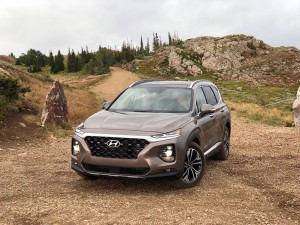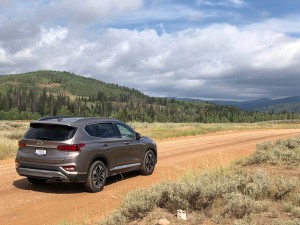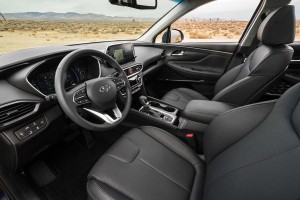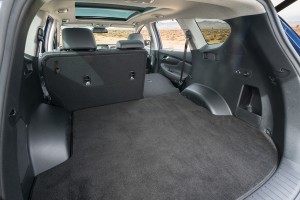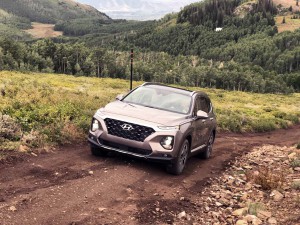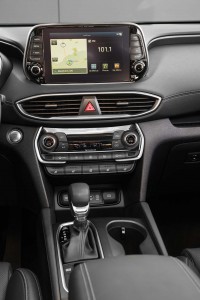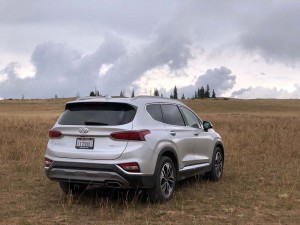There’s an old baseball adage: you can’t tell the players without a scorecard. That just might apply to the Hyundai Santa Fe. What started out as one sport-utility vehicle back in 2001 morphed into two, a few years back, with a new, three-row model retaining the Santa Fe name while the smaller, two-row became the Santa Fe sport.
With the fourth-generation crossover just coming to market, buyers might get a little confused. The three-row is now the Santa Fe XL – for extra length, we’ll assume – while the smaller version drops the Sport badge.
It would be too bad if any potential buyer is put off by this name game. The 2019 Hyundai Santa Fe has a lot going for it, and relatively few things to quibble about. While it retains the Korean carmaker’s traditional focus on “value pricing,” it is anything but cut-rate, with a number of features that give the gen-four Santa Fe a much more upscale feel than many of its mainstream competitors. And, despite the shortened name, it feels even more sporty than the outgoing SUV.
(Click Here for a first look at the 2019 Hyundai Elantra.)
To get a feel for the 2019 Hyundai Santa Fe we headed out to Park City, Utah for a few 100 miles of on and off-road driving through some of the more scenic country in the Western U.S.
The new Santa Fe grows in every key dimension, adding 2.8 inches in overall length, 2.6 more inches of wheelbase, 0.4 inches extra width and another 0.6 inches in height, to 187.8, 108.9, 74.4 and 67.1 inches, respectively. Meanwhile, cargo space is also up, with 35.9 cubic feet with all seats up, and 71.3 cf with the back row down.
At first glance, one can recognize that Hyundai has made some significant changes to the design of the Santa Fe, a video presentation ahead of our drive emphasizing the goal of “making it more of an SUV (and) less of a minivan.”
That starts with a much more upright face that adopts a new, “cascading” grille design, the polygonal shape getting a more chain mail-like texture. The hood itself is a bit longer, with shorter overhangs and a more “proud,” or upright, windshield.
The fenders are flared more than before and, straddling the corners are new air curtains, a feature we’re finding on almost everything these days, it seems, but there’s a purpose, as it helps reduce turbulence around the front wheels, a fuel-saving aerodynamic touch. From the side, meanwhile, you’ll notice that the mirrors are now attached to the body, rather than the window frames.
That has several advantages, improving visibility while also reducing wind noise. And once you’re cruising at highway speeds one of the most noticeable improvements on the 2019 Santa Fe is the sharp reduction in wind and road noise. It’s not quite Lexus tomb quiet, but it comes surprisingly close, something that’s all the more impressive in an SUV with its open cargo bay.
From the back, the 2019 SUV adopts strip-like taillights that stretch further across the rear of the ute.
The shape of the grille carries over inside the cabin where the instrument panel takes on a wave-like shape. The overall layout is attractive yet functional, with controls and read-outs well placed and within easy reach. There are plenty of USB ports and readily accessible storages bins and pockets – including one of the most well thought-out touches, a slot above the glovebox big enough to handle a paperback book.
(Exclusive: Hyundai Santa Cruz pickup set to debut in late ’20 or ’21. Click Here for more.)
We spent most of our time in the Santa Fe Ultimate, the top-tier model, and we were impressed by the use of materials, including not just the contrast stitching on the seats, doors and instrument panel, but the material used for the ceiling and pillars, the sort of fabric you’d find on modern, upscale furniture. That said, there are a few places where Hyundai cut corners with hard plastic, but the overall look is definitely a step ahead of the gen-3 Santa Fe, even on base and mid-range trim levels.
The instrument panel on most of those versions features a 3.5-inch MIDI, or LCD display filling the gap between the speedometer and tachometer. The Ultimate and other top trims get upgraded to a 7-inch virtual cluster that mixes the LCD display with a traditional tach. The colors of the digital display change depending upon which of the three modes you’ve set the Santa Fe up in: Eco in green, of course, Normal in blue and Sport in red.
Those modes adjust throttle, transmission and steering calibrations, incidentally, but not the Santa Fe’s suspension.
We have to give Hyundai kudos for not trying to follow another questionable industry trend. There’s a 7-inch touchscreen in most models, and an 8-inch display on versions with navigation. Whichever you opt for, you still get both volume and tuning knobs.
Another plus: surprisingly comfortable seats that still have a reasonable level of grip to keep you in place even when bouncing along a gravel road of sweeping around tight mountain curves. On our Ultimate we got eight-way power front seats, the driver’s adding an extendible cushion under the thighs.
We’ve had a chance to drive a number of competing models lately and found the Santa Fe to be one of the most competent, in terms of ride and handling, among mainstream offerings. No, the emphasis isn’t on “sport”, but more on utility. That said, we were able to flog it around those high mountain roads with reasonable aplomb and rarely heard a chirp from the tires.
For those familiar with early generations of Hyundai products, ride and handling, and especially steering, were among the brand’s biggest weaknesses. No longer. The new Santa Fe offered good road feedback and didn’t suffer from the over-boosted steering we find on many competitors. The overall feel is taut and agile,
Credit, in part, the MacPherson struts up front and the multi-link rear suspension. Our Santa Fe Ultimate also was equipped with Hyundai’s HTRAC All-Wheel-Drive system which, the automaker claims, can predict, rather than just react, to road conditions and driver input, nimbly moving torque front and back while also torque vectoring. That became obvious when we overcooked things going into a couple sharp turns and felt subtle inputs helping keep us on the correct side of the double-yellow line.
(Hyundai enters the “hot hatch” segment with sporty Veloster N. Click Here to check it out.)
One of the things you’ll likely notice during a visit to Park City is just how thin the air is at 8,500 feet of altitude. Even simple tasks, like climbing a couple flights of stairs left many of the event’s attendees gasping for breath.
You’d expect to find that applying to internal combustion engines, and you’d be right, which is why few automakers are willing to go to these extreme heights when showing off a new vehicle.
That helped explain why we only had limited opportunity to drive the 2.4-liter naturally aspirated engine on base and some mid-trim models. While it might make 185 horsepower and 178 pound-feet of torque at lower elevations, it gasped for air like the rest of us at upper elevations.
The 2.0-liter turbo-four in the Ultimate didn’t entirely escape oxygen deprivation, revealing some clear turbo lag – though it started to disappear as we came down to lower elevations during various points along our drive route. To their credit, Hyundai officials didn’t discount that issue, with the automaker’s senior U.S. powertrain manager telling us it will be one of the first things he plans to address in coming weeks. The question is whether that can be dealt with by software tweaks.
We’re going to give Hyundai a pass on altitude sickness. As we said, we’ve seen very, very automakers willing to climb this high up from sea level to show off a new product and we know few products would have escaped this problem. For the vast majority of American buyers who live at altitudes below that of, say, Denver’s, we expect the turbo lag to be all but absent. And, even at upper elevations, the turbo-four was more than up to the task of moving us from Point A to B and all points in-between. If anything, it just seemed to want to settle into a cruising speed of 70 to 80 mph.
Both engines, incidentally, are paired with a smooth new eight-speed automatic developed and manufactured in-house by Hyundai. Other than under hard acceleration in Sport mode, it operated almost transparently.
If there’s one other modest weakness to the powertrain it’s fuel economy – even though Hyundai actually reduced the weight of the 2019 Santa Fe to 3,591 pounds, down 33 lbs from the old Santa Fe Sport. It hovers somewhere mid-pack, the 2.4-liter package making 22 mpg City, 29 Highway and 25 Combined. The peppier turbo, which punches out 235 hp and 260 lb-ft of torque, delivers 20 mpg City, 25 Highway and 22 Combined.
Safety is another part of the Hyundai value equation that becomes even more appealing on the 2019 Santa Fe. From bottom to top, there are a number of advanced safety features, including automated emergency braking, lane-departure warning and lane-keeping assist, driver-attention warning, automatic high-beams, rear cross-traffic alert, and blind-spot monitoring with avoidance assist.
Add several features unique to Hyundai: the new Safe Exit Assist and Rear Occupants Alert systems. Park parallel to the road and the former will warn you if a car, motorcycle or bike is approaching. It will even keep the doors locked, under certain conditions, so you and your children don’t inadvertently step out into traffic.
Rear Occupant Alert addresses an issue that results in the death of dozens of children each year. As hard as it might seem to believe, parents and caregivers all too often leave kids – and pets – in the car when they exit. Even when temperatures are temperate, the inside of a car can quickly become boiling hot, leading to heatstroke and a potential death. Several automakers have developed systems that remember you opened the back door. Santa Fe also can detect motion if someone is left in back. If that happens it will not only beep the horn but even send your smartphone an alert.
As to cost, the base 2019 Hyundai Santa Fe SE starts at $25,500, with the Ultimate priced at $35,450. Add $985 for delivery, and the HTRAC AWD system is $1,700.
On price alone, the Korean ute has an edge over most of the competition. But when you add in the features, handling and overall performance, well, the 2019 Santa Fe is going to be hard for compact SUV buyers to ignore.
Oh, and for those looking at the three-row XL we’ll have more to say soon. Meanwhile, expect that stretched Santa Fe to be winding down production at the end of this model-year. We’ll see an all-new, Hyundai three-row model come along in 2020.

